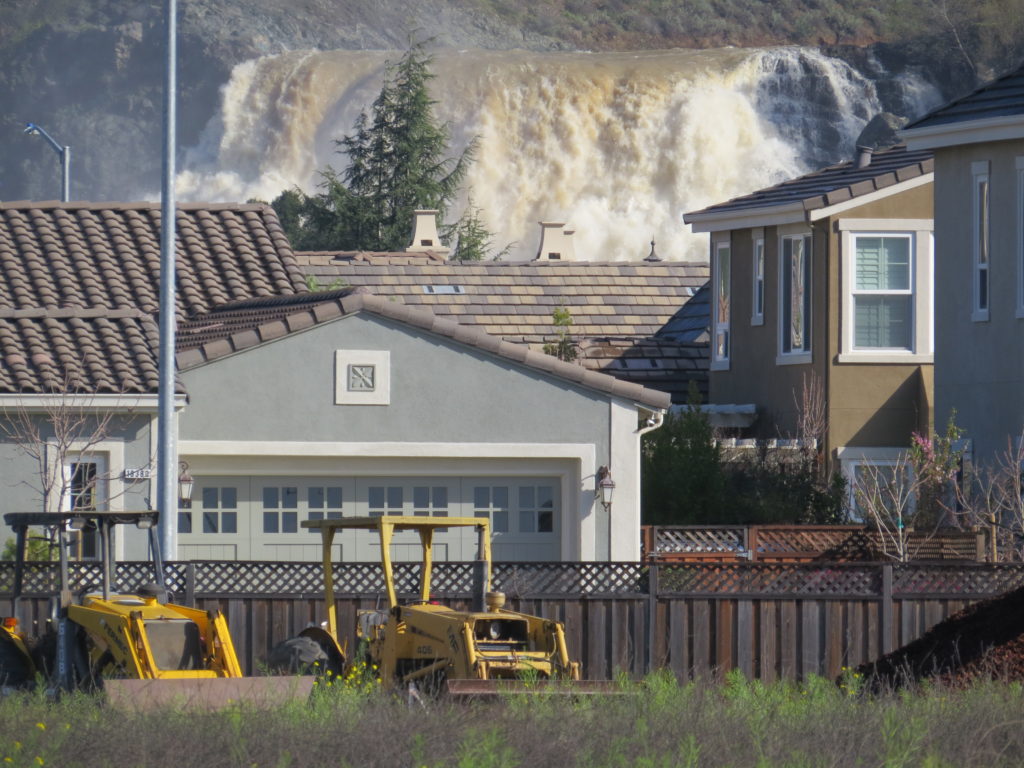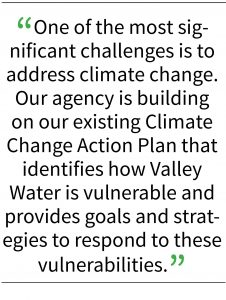One of our most significant challenges is to address climate change.

Morgan Hill Life file photo
Water flows over the spillway of Anderson Dam after heavy rains drenched the South Valley in February 2017.
By Tony Estremera

Tony Estramera
This year, I have the privilege of serving as chairperson of the Valley Water Board of Directors. Our agency and community are facing many challenges, and I look forward to addressing those issues head-on.
In this leadership position, my goal is to make sure our board is action-oriented and forward-thinking. I also want to make sure our board represents all people and responds to their needs. This is incredibly important as we continue to seek solutions to the many water-related challenges facing our communities.
One of our most significant challenges is to address climate change. Our agency is building on our existing climate change efforts by developing a Climate Change Action Plan that identifies how Valley Water is vulnerable and provides goals and strategies to respond to these vulnerabilities. These goals and strategies address all of Valley Water’s mission areas, including water supply reliability, flood risk reduction, and water resources stewardship, as well as emergency response.
 As we’ve seen in recent years, weather is becoming more extreme. And it now appears we are entering another drought, with no way of predicting how long it may last.
As we’ve seen in recent years, weather is becoming more extreme. And it now appears we are entering another drought, with no way of predicting how long it may last.
Our board is prudently exploring ways to secure enough water to help all our communities weather future droughts and be better protected against flooding.
Our agency continues to evaluate the proposed expansion of Pacheco Reservoir in south Santa Clara County as an option to increase the amount of water we can store for emergencies. We are gathering input from our community, and our board will consider the costs and environmental factors as we assess the project.
We are also engaged in potential partnerships for water storage outside our county, including the Sites Reservoir Project in the Sacramento Valley and the Los Vaqueros Reservoir Expansion Project in Contra Costa County.
 Fixing Anderson Dam so it can safely withstand a large earthquake remains a top priority. We expect to begin construction this year on a larger outlet tunnel which will allow us to better manage water levels in Anderson Reservoir.
Fixing Anderson Dam so it can safely withstand a large earthquake remains a top priority. We expect to begin construction this year on a larger outlet tunnel which will allow us to better manage water levels in Anderson Reservoir.
Once the tunnel is complete, Valley Water will begin rebuilding the dam and spillway.
My fellow board members and I continue to support the Delta Conveyance Project, the state’s proposed plan to improve the infrastructure that carries water through the Sacramento-San Joaquin Delta.
 Santa Clara County relies on water imported through the Delta for about 40 percent of its water supply. These supplies are at risk from sea level rise and levee failures due to earthquakes and flooding. Valley Water is working with other public water agencies in the Bay Area and across California to protect and maintain these vital supplies. Valley Water’s Board of Directors continues to support the Delta Conveyance Project as the most cost-effective approach to secure this water.
Santa Clara County relies on water imported through the Delta for about 40 percent of its water supply. These supplies are at risk from sea level rise and levee failures due to earthquakes and flooding. Valley Water is working with other public water agencies in the Bay Area and across California to protect and maintain these vital supplies. Valley Water’s Board of Directors continues to support the Delta Conveyance Project as the most cost-effective approach to secure this water.
Recycled and purified water is another vital component of our future water supply.
Our board has worked to create partnerships across Santa Clara County to expand our recycled water supply, which is an important drought-resilient, locally controlled water supply. We are working on expanding our existing partnership with the city of San Jose, and we are engaging to expand that supply with cities in south Santa Clara County. In 2019, our board agreed to a partnership with the cities of Palo Alto and Mountain View to expand recycling and advanced purified water efforts. All of these efforts bolster our drought resilience, and better prepare us for the current and future droughts.
I view all our work at Valley Water through the lens of environmental stewardship. We must commit to preserving our environment as best we can.
Our agency is conducting some important studies that will help our fisheries survive and thrive. Last fall, Valley Water biologists tagged 113 juvenile Central California Coast Steelhead with tiny microchip devices to track their movement as they migrate to the ocean.
With the recent installation of an automated fish counter in Stevens Creek, Valley Water can monitor the steelhead migration in the Guadalupe, Coyote, and Stevens Creek watersheds. These studies will allow our biologists to better understand when steelheads start their journey to and from the Pacific Ocean.
Finally, I’d like to thank our community for their continued support.
In November, Santa Clara County voters overwhelmingly approved Measure S, a renewal of Valley Water’s Safe, Clean Water and Natural Flood Protection Program. The Safe, Clean Water Program funds will continue to provide about $45.5 million annually for local projects that support our mission.
Our board will address whatever challenges come our way to ensure all our communities and future generations have safe, clean water, flood protection and a healthy environment.
Tony Estremera is the chair of the Valley Water board of directors. This column was originally published in the Valley Water newsletter in March.






